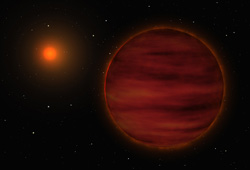The Sun’s New Exotic Neighbour

New Brown Dwarf in the Solar Neighbourhood (Artist’s Impression) - copyright ESO
Very Cool Brown Dwarf Discovered Around Star in the Solar Neighbourhood
Using Eso’s Very Large Telescope in Chile, an international team of researchers [1] discovered a brown dwarf belonging to the 24th closest stellar system to the Sun. Brown dwarfs are intermediate objects that are neither stars nor planets. This object is the third closest brown dwarf to the Earth yet discovered, and one of the coolest, having a temperature of about 750 degrees Centigrade. It orbits a very small star at about 4.5 times the mean distance between the Earth and the Sun. Its mass is estimated to be some-where between 9 and 65 times the mass of Jupiter.
At a time when astronomers are peering into the most distant Universe, looking at objects as far as 13 billion light-years away, one may think that our close neighbourhood would be very well known. Not so. Astronomers still find new star-like objects in our immediate vicinity. Using Eso’s VLT, they just discovered a brown dwarf companion to the red star SCR 1845-6357, the 36th closest star to the Sun.
“This newly found brown dwarf is a valuable object because its distance is well known, allowing us to de-termine with precision its intrinsic brightness”, said team member Markus Kasper (ESO). “Moreover, from its orbital motion, we should be able in a few years to estimate its mass. These properties are vital for understanding the nature of brown dwarfs.”
To discover this brown dwarf, the team used the high-contrast adaptive optics NACO Simultaneous Differential Imager (SDI [2]) on Eso’s Very Large Telescope, an instrument specifically developed to search for extrasolar planets. The SDI camera enhances the ability of the VLT and its adaptive optics system to detect faint companions that would normally be lost in the glare of the primary star. In particular, the SDI camera provides additional, often very useful spectral information which can be used to determine a rough temperature for the object without follow-up observations.
Located 12.7 light-years away from us, the newly found object is nevertheless not the closest brown dwarf. This honour goes indeed to the two brown dwarfs surrounding the star Epsilon Indi, located 11.8 light years away (see ESO PR 01/03).
However, this newly discovered brown dwarf is unique in many aspects. “Besides being extremely close to Earth, this object is a T dwarf – a very cool brown dwarf – and the only such object found as a compan-ion to a low-mass star,” said Beth Biller, a graduate student at the University of Arizona and lead author of the paper reporting the discovery. “It is also likely the brightest known object of its temperature be-cause it is so close.”
The discovery of this brown dwarf hints that, at least close to the Sun, cool brown dwarfs prefer to be part of a couple with a star or another brown dwarf, rather than wandering alone in the cosmic empti-ness. Indeed, of the seven cool brown dwarfs that reside within 20 light years of the Sun, five have a companion.
“This has wide-ranging implications for theories of brown dwarf formation, which, until now, tend to favour the production of single brown dwarfs,” said team member Laird Close (University of Arizona).
Notes
[1]: The team is composed of Beth Biller and Laird Close (Steward Observatory, University of Arizona, Tucson, USA), Markus Kasper (ESO, Garching, Germany), Wolfgang Brandner (Max-Planck Institute for Astronomy, Heidelberg, Germany), and Stephan Kellner (W.M. Keck Observatory, Waimea, Ha-waii, USA).
[2]: The NACO SDI camera is a unique type of camera using adaptive optics, which removes the blur-ring effects of Earth’s atmosphere to produce extremely sharp images. SDI splits light from a single star into four identical images and then passes the resulting beams through three slightly different (methane-sensitive) filters. Only cool low-mass objects will have methane in their atmospheres and so only these objects will change brightness in the SDI filters. When the filtered light beams hit the camera’s detector array, astronomers can subtract the images so the bright star disappears, revealing a fainter, cooler object otherwise hidden in the star’s scattered light halo (“glare”). The SDI camera was developed and deployed by Laird Close (Steward Observatory, University of Arizona) and Rainer Lenzen (Max-Planck-Institute for Astronomy in Heidelberg) in collaboration with Eso.
Media Contact
More Information:
http://www.eso.org/outreach/press-rel/pr-2006/pr-11-06.htmlAll latest news from the category: Physics and Astronomy
This area deals with the fundamental laws and building blocks of nature and how they interact, the properties and the behavior of matter, and research into space and time and their structures.
innovations-report provides in-depth reports and articles on subjects such as astrophysics, laser technologies, nuclear, quantum, particle and solid-state physics, nanotechnologies, planetary research and findings (Mars, Venus) and developments related to the Hubble Telescope.
Newest articles

Properties of new materials for microchips
… can now be measured well. Reseachers of Delft University of Technology demonstrated measuring performance properties of ultrathin silicon membranes. Making ever smaller and more powerful chips requires new ultrathin…

Floating solar’s potential
… to support sustainable development by addressing climate, water, and energy goals holistically. A new study published this week in Nature Energy raises the potential for floating solar photovoltaics (FPV)…

Skyrmions move at record speeds
… a step towards the computing of the future. An international research team led by scientists from the CNRS1 has discovered that the magnetic nanobubbles2 known as skyrmions can be…





















